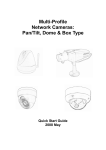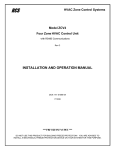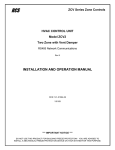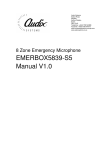Download Ansel Vandal P/T Installation guide
Transcript
Multi-Profile Network Cameras: Pan/Tilt & Dome Type Quick Start Guide 2007 Dec. Table of Contents 1. System Requirements ........................................................................................... 3 2. Physical Installation.............................................................................................. 3 2.1 Indoor IP Dome Camera Installation.......................................................... 4 2.2 Vandal IP Dome Camera Installation ......................................................... 6 2.3 P/T IP Camera Installation.......................................................................... 8 3. Camera administration........................................................................................ 10 4. 3G Mobile Phone (3GPP) Usage.........................................................................11 2 About multi-profile Multi-profile stands for simultaneously video streams. The Network Camera can generate MPEG4 and MJPEG streaming simultaneously to different clients. Moreover, the resolution can be different from one client to another. This state-of-art design is considerable to fit in various network environments. Before Installation Before installation, please be sure to read this quick installation guide and user’s manual carefully to complete machine installation. 1. System Requirements Multi-Profile Network Camera Network Environment Network Interface 10/100MBase-TX Ethernet Monitoring System Recommended for Internet Explorer 6.0 or later System Hardware · CPU: Pentium 4, 2GHz or above · Memory Size : 512 MB or above · VGA card resolution : 1024 x 768 or above - Sound card: for 2-way audio funciton · Network bandwidth: In VGA resolution mode, minimum upload bandwidth is 1M bit. In QVGA or QQVGA mode, no limitation System Requirement for Viewer & Recorder Application Support OS Win 2000 , Win XP, Win Vista System Hardware 16 cameras surveillance application · CPU: Pentium D, 2.8GHz or faster · Memory Size : 512 MB or above · VGA card resolution : 1024 x 768 or above 2. Physical Installation Connections: All dome type cameras have the same cables for connection as below: RJ45 LAN (Vandal dome is male type IR IP Dome is female type). Video out Line in Line out 3 RS485 & DI/DO (Connect to a TEL box) 12V DC in 1. RJ45 LAN socket: Connect to PC or Hub/Switch. For connections to 10Base-T Ethernet or 100Base-TX Fast Ethernet cabling. This Ethernet port built N-Way protocol can detect or negotiate the transmission speed of the network automatically. Please use Category 5 “straight through” cable to connect the Network Camera to a 100Mbps Fast Ethernet network switch or hub. Note that, in case you need to connect the device to PC or notebook directly, you should use cross over cable instead. 2. RS-485: Connect to a local keyboard controller. DI/ DO: Connect to sensor in and alarm out devices Inside the TEL box: Name Function 12VDC DC 12V (50mA maximum) GND GND D+ RS485 data + DRS485 data DI Digital signal input DO Digital signal output 3. Local Video output (BNC port) The Network Camera also provides composite video output. User can use BNC video cable to connect the Network Camera with a TV monitor or VCR. 4. DC-in Jack The input power is 12VDC. Note that supply the power to the Network Camera with the power adapter included in package. 5. Line in (audio in) Connect an audio input source to the speed-dome network camera. 6. Line out (audio out) Connect a loud speaker to the speed-dome network camera. This function is for voice alerting and two-way audio. 2.1 Indoor IP Dome Camera Installation 1. Drill 20mm (3/4") holes in the ceiling or wall and then align the mounting plate to the holes you have made as below. Ceiling Top Plate 4 2. Directly install on any horizontal or vertical surface 3. Alternatively, fixed with wall mount bracket (option). Option: Bracket 4. Camera Adjustment: 4.1. X-axis 4.2. Y-axis Tilting View Angle range is 0o~90o Rotating View Angle range is 0o~90o 4 5 4.3. Z-axis Panning View Angle range is 0o~180o 5. Connect the necessary cables and connectors: - Plug-in Ethernet Cable into LAN port (necessary) - Connect the attached power adapter to camera and plug-in this adapter into power outlet (necessary) - Connect Video BNC connector to a local TV if necessary (to check camera viewing angle) 6. Done. 2.2 Vandal IP Dome Camera Installation 1. Use the provided L-wrench, loosen the vandal-resistant housing cover (with screws still attached on the cover). 2. Set the mounting base onto the wall or ceiling and center it over the mounting hole, using the supplied four retaining screws to secure the main body. 6 3. Set the proper image by moving the camera body (3-axis) and set the focus by turning the lens to the left or right direction. 4. When the camera focus adjustment has been completed, use the provided L-wrench to fasten the vandal-resistant housing to the main body. 5. When using the side conduit cabling, it is suggested to cover the cables using metal covers (to prevent external damage and for waterproof prevention), and wined the waterproof adhesive tape (P.T.F.E. THREAD SEAL TAPE) onto the metal cover before installation. 6. Connect the LAN cable to Ethernet’s switch or hub, the video cable to video output to the monitor or other video device through a 75 Ohms type coaxial cable and the DC-Jack to the power source. 7. Vari-Focal Dome Operation Guide: Once the picture appears on the monitor, open the cover and adjust the lens wrench to “NEAR←→FAR”, get the view zoom that you desire, and then adjust the focus wrench of the lens to obtain the best picture. After adjustment, tighten both wrenches. Zoom Adjustment NEAR TELE FAR WIDE 8. Connect the necessary cables and connectors: 7 Focal Adjustment - Plug-in Ethernet Cable into LAN port (necessary) - Connect the attached 12V power adapter to camera and plug-in this adapter into power outlet (necessary) - Connect Video BNC connector to a local TV if necessary (to check camera viewing angle) 9. Done 2.3 P/T IP Camera Installation Connections: Audio Output Jack Antenna Connector LAN Socket Factory Default Reset DC Power Jack Audio Output Jack It allows this device to output audio or alerting sound. Connect with a 3.5Ø phone jack speaker (external adaptor) DC Power Jack The input power is 12VDC. Note that supply the power to the Camera with the power adapter included in package. Otherwise, the improper power adapter may damage the unit and result in danger. Antenna Connector User can attach the included wireless antenna to this connector (SMA type) or use another high-gain antenna to get higher performance. LAN Socket The LAN socket is a RJ-45 connector for connections to 10/100Base-TX Fast Ethernet cabling. This Ethernet port built N-Way protocol can detect or negotiate the transmission speed of the network automatically. Please use Category 5 “straight through” cable to connect the Network Camera to a 100Mbps Fast Ethernet network switch or hub. Note that, in case you need to connect the device to PC or notebook directly, you should use “cross-over” cable instead. Factory Default Reset This button is hidden in the pinhole. Please refer to the Appendix A in this manual for 8 more information. P/T IP Camera Installation: Ceiling Mount 1. Fix the camera to L-type bracket with the two supplied screws 2. Fix the bracket and camera to the ceiling using two holly wall anchors and screws Wall Mount 1. Fix the L-type bracket to the wall using two holly wall anchors and screws 2. Fix the camera to L-type bracket with the two supplied screws 9 3. Camera administration When you installed your networked device over your network environment, to start Network Camera web configuration, you must have the web browsers installed on computer for web management. - Microsoft internet Explorer 6.0 or higher At first, user may use “IP Wizard” utility to search all networked devices in the LAN. Use “IP Wizard” to locate IP address Press “Search” button. IP Wizard will list all networked devices in the LAN: Wizard function: The utility featured with “Wizard” function to help user to modify the IP parameters of the installed network devices. User can step by step to setup IP address, username and password. Username and Password: The networked devices will prompt for User Name and Password. Default username is: admin, leave password blank. Note 1: If no IP address is assigned within 30 seconds, the networked device will automatically assign 192.168.0.100. User may now open your web browser, and key in http://192.168.0.100 in the address bar of you web browser to logon Network Camera’s web configuration page. Note 2: If you have problem when connecting the network camera to a router, please read user’s manual inside CD, the section “Installation to a router”. After connected to networked device, the device will prompt for User name and Password. For the first time, please enter: admin as username to continue machine Web Management. 10 If difficulty is met, please refer to the following steps to establish the connection: - The networked device must be installed and powered ON. - If the networked device’s default IP Address (192.168.0.100) is already used by another device, the other device must be turned OFF until the device is allocated a new IP Address during configuration. 4. 3G Mobile Phone (3GPP) Usage The device is 3GPP compatible by default. To view live video over 3GPP, here is a briefly steps. Please check user's manual inside product CD for detail Step 1: You must apply a 3G mobile phone with 3GPP service. Please contact your 3G telecom service provider for detail. Step 2: Check that the IP camera has a completely PUBLIC IP address, i.e. no ports blocked by a firewall. It is highly recommended that you have a fixed and public IP address without any firewall blocked Step 3: check RTSP port and the default port is 554. Step 4: Bitrate Setting Î Video Î MP4/QQVGA Î Bit rate, set the maximum bit rate to lower than 128 kbit/s. To use the 3GPP function, in addition to previous section, you might need more information or configuration to make this function work. Note that to use the 3GPP function, it strongly recommends to install the Networked Device with a public and fixed IP address without any firewall protection. 11 Mobile Phone Dialing procedure: Step 1: Contact your cell phone provider and make sure that 3GPP service is available. Support cell phone list please keep contact with your Network Camera sales. Step 2: Enable “internet access” function on your mobile phone. Some telecom will automatically download the setup profile to your mobile phone; some telecom need you call the service center to enable the internet access function Step 3: Choose a verified video player, RTSP streaming supported (ex. Realplayer or PacketVideo) Step 4-1: Open the video player. Base on your requirement, type either URL address (for firmware version 2.x): rtsp://host/avN for both audio and video tracks. rtsp://host/videoN for video track only. rtsp://host/audio for audio track only. Where host is the host name or IP address of the camera, and N is the number of the profile (between 2 and 3) for the video stream. Step 4-2: For firmware version 3.x: rtsp://host/mpeg4/media.3gp Where host is the host name or IP address of the camera. IP camera video or audio will show up on your player now! Made in Taiwan All Rights Reserved 2007 12




















